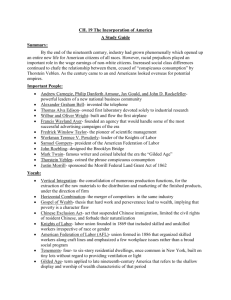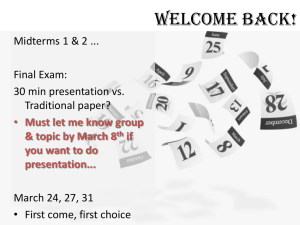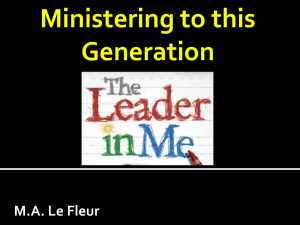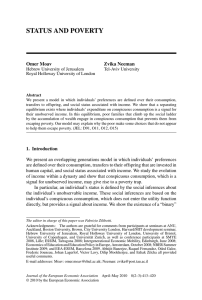Conspicuous Consumption and Poverty University of Warwick 12.2.13 Omer Moav
advertisement
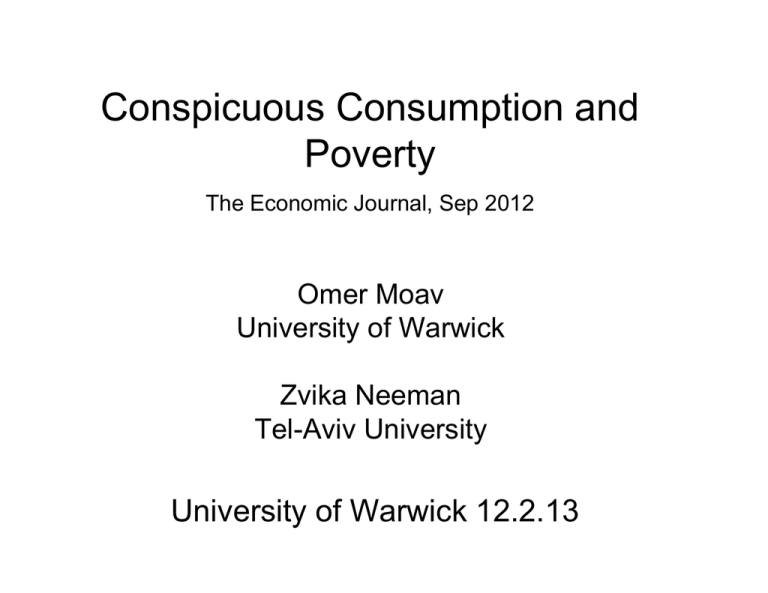
Conspicuous Consumption and Poverty The Economic Journal, Sep 2012 Omer Moav University of Warwick Zvika Neeman Tel-Aviv University University of Warwick 12.2.13 • Poor families around the world spend a large fraction of their income on consumption of goods that appear to be useless in alleviating poverty while saving at very low rates and neglecting investment in health and education. This Paper: • We offer an explanation for this observation, based on a trade-off between conspicuous consumption and human capital as signals for income. Evidence Banerjee-Duflo (2007) show that the typical poor: • scarcely invest in their children's education • are poorly fed • suffer from health problems • are worried and anxious to an extent that interferes with their sleep and work • fail to make trivial investments in their businesses • save so little that they cannot avoid cutting on their meals when they suffer a temporary decline in income Evidence cont. Yet, they spend a large fraction of their income on alcohol, cigarettes, and festivals, among other goods that seem useless in alleviating poverty Evidence cont. The New York Times (May 22, 2010) "Moonshine or the Kids?" • The reporter argues that “if the poorest families spent as much money educating their children as they do on wine, cigarettes and prostitutes, their children’s prospects would be transformed”. Evidence cont. • The Obamza family from the Congo Republic is eight months behind on the $6-a-month rent and is in danger of being evicted. • The Obamzas have no mosquito nets, even though they have already lost two of their eight children to malaria. They say they just can’t afford the $6 cost of a net. • Nor can they afford the $2.50-a-month tuition for each of their three school-age kids. Evidence cont. • Mr. and Mrs. Obamza spend a combined $10 a month on cell phones • Mr. Obamza goes drinking several times a week at a village bar, spending about $1 an evening. By his calculation, that adds up to about $12 a month. Evidence cont. • Mr. and Mrs. Obamza spend a combined $10 a month on cell phones • Mr. Obamza goes drinking several times a week at a village bar, spending about $1 an evening. By his calculation, that adds up to about $12 a month. • Other villagers said that Mr. Obamza drinks less than the average man in the village Evidence cont. • Bloch-Rao-Desai (2004) and others emphasize the prestige motive underlying marriage expenses. Argue that daughter's marriage (dowry and celebrations) could amount to more than six times a family's annual income • Rao (2001) festivals amount to15% of households expenditures in rural India Evidence cont. Case et al. (2008) Households in South Africa spend the equivalent of a year's income for an adult's funeral, financed, in many cases, by borrowing. Evidence cont. The New York Times (March 18, 2010) “For India’s Newly Rich Farmers, Limos Won’t Do” • A newly rich farmer who sold land for about $109,000, rented a helicopter for $8,327 to transport his son to his wedding two miles away. • The claim in the article, supported by statements from family members and experts, is that the intention is to impress other villagers with the family’s new status and spending power. . Evidence cont. National Public Radio (2008)/ Radio Free Europe (2007) • Tajikistan's President, Imomali Rahmon, banned gold teeth, the use of cell phones in universities and big birthday parties. • The President criticized wealthy citizens “for ‘showing off their wealth’ by throwing elaborate parties and thereby setting a standard for others who try to appear wealthy by holding a large party despite having only modest incomes." • The President restricted the number of people at weddings to prevent Tajiks from “using their life savings just to compete with their neighbors” Evidence cont. • Charles-Hurst-Roussanov (QJE 2009) college educated spend about 13 percent less than their high school educated counterparts on visible expenditures, controlling for current and permanent income. Trade-off between race and cons. as signals for success. Evidence cont. • Pinker (2003) How the Mind Works status is in our genes and conspicuous consumption is universal • Wilson-Daly (2004) pretty women inspire men to discount the future • Griskevicius et al (2007) mating goals in men increase their willingness to spend on conspicuous luxuries (and display heroism or dominance). In women, mating goals boost public helping. Evidence cont. • Missy Elliott (2004) bling bling culture (flashy jewelry worn especially as an indication of wealth) encourages young black men and women to spend their money irresponsibly. Artists should encourage young people to invest responsibly in stable, long-term assets Page 1 of 1 http://pro.corbis.com/images/CB011775.jpg?size=572&uid=%7BA5D78B88-400B-45... 3/31/2008 Related Literature Conspicuous Consumption Background: Veblen (1899) and others Formal models: Study the implications of conspicuous consumption wrt market prices and savings. • Identify positive and negative effects on economic growth. Notable contributions include: Frank (1985, 1986), Basu (1989), Ireland (1994), Corneo-Jeanne (1994), Glazer-Konrad (1996), Bagwell-Bernheim (1996), Hopkins-Kornienko (2004) Related Literature Savings and Income Friedman (1957): the observation that rich individuals save more is due to the smoothing of consumption Dynan, Skinner, and Zeldes (2004): higher lifetime income households save a larger fraction of their permanent income Dynan et al. conclude that their finding is inconsistent with: • the standard life cycle model with homothetic preferences • explanations that are based on differences in time preference rates • subsistence consumption • variation in Social Security replacement rates. It is consistent with: • hyperbolic discounting • differential asset accumulation against out-of-pocket health expenditures late in life The explanation that is offered here is also consistent with their finding Related Literature Poverty Traps The dynamics of wealth within a dynasty: yt+1 bt bt yt yt+1 bt yt bt φ(yt) yt+1 yt yt+1 bt yt bt 450 φ(yt) yt+1 y yt Unique Steady-State no poverty trap 450 yt+1 y φ(yt) yt Multiple Steady-States require a range of φ''(yt)>0 450 yt+1 φ(yt) yL yH yt yt+1 bt b̂ bt yt 450 Dasgupta-Ray (1986) Banerjee-Newman (1993) φ(yt) yt+1 Galor-Zeira (1993) Piketty (1997) Maoz-Moav (1999) And many others yL yH yt 450 φ(yt) yt+1 yL yH yt yt+1 bt bt yt 450 φ(yt) yt+1 Moav (2002) Moav (2005) Banerjee-Mullainathan (2007) Moav-Neeman (2010) yL yH yt In this paper: a trade-off between conspicuous consumption and education as signals for income: Æ increasing saving rates with income Æ persistence of poverty yt+1 bt yt bt φ(yt) AK Model yt+1 450 yt AK Dynamics φ(yt) yt+1 450 yt Conspicuous Consumption as a signal of income yt+1 450 φ(yt) yL yt Cons. Consumption + HC as signals of income yt+1 φ(yt) yL 450 yt Note that a poverty trap implies: φ ' ( yt ) < 1 φ ' ( yt ) > 1 Followed by φ(yt) 450 yt+1 yL yt The Model Individuals Live two periods in OLG: childhood and adulthood Each child has one adult parent Each adult has one child Childhood - invest in HC Adulthood - work and allocate income between: c - consumption b - bequest x - conspicuous consumption Income (at adulthood) y h ≥ 0 h - observed human capital - unobserved income budget constraint: cbx ≤ y Preferences: u Bc 1− b 1− S ∈ 0, 1 ∈ 0, 1 B 1 − −1 − 1− S Ey |h, x is determined in equilibrium Optimization with respect to b and c: b y − x c 1 − y − x Replacing in the utility function: u y − x 1− S The Production of HC (at childhood) h t1 b t → y t1 h t1 t1 b t t1 Assumptions: 1 1 − 1 Equilibrium xh, y - individual’s conspicuous consumption Ey |h, x ≡ yh, x - social beliefs about individual’s expected income A pair xh, y and yh, x is an equilibrium if: 1. xh, y is optimal given yh, x 2. yh, x is consistent with xh, y Equilibrium B e lie fs S trate gy y (h,x) x (h,y) A simple example for a signaling equilibrium Income w is 8 or 12 Utility: w − xS A separating equilibrium: Beliefs: S 12 if x ≥ 3 8 if x 3 Conspicuous consumption: x 3 if w 12 0 if w8 w8 w 12 x0 x3 88 8 − 3 12 64 60 12 8 12 − 3 12 96 108 A pooling equilibrium: Beliefs: S x0 8 or 12 if 8 otherwise Conspicuous consumption: x0 The intuitive criterion (Cho & Kreps), which is the standard refinement applied to equilibria in signaling games, rules out a pooling equilibrium Back to the model: u y − x 1− S S Ey |h, x ≡ yh, x y h ≥ 0 h ≥ 0 - observable human capital - unobservable income - drawn from a continuous distribution ∈ h, h h ∈ −h, 0 E 0 Individuals’ maximization problem is 1− − x yh, x max y x → FOC y−x 1 1 − yh, x dyh, x dx LHS - marginal rate of substitution u S /u y−x RHS - marginal cost of status inverse of the marginal effect of the signal on beliefs (the cost of b and c is 1 Under a fully separating equilibrium y Ey |h, x ≡ yh, x Replacing in the F. O. C yh, x − x 1 1 − yh, x dyh, x dx A solution y yh, x of the differential equation is given by: yh, x 1/1− − x yh, x /1− yh 1/1− yh ≡ h h →The signal x is an explicit function of y and h: 1/1− yh xy, h y − y /1− This solution is the unique fully separating equilibrium 1. The MRS is unique for any bundle → a unique marginal cost of status 2. in a fully sep. eq. x 0 for y yh → yh, 0 yh An equilibrium that meets the intuitive criterion (Cho & Kreps) is fully separating The fully separating equilibrium is unique Conspicuous Consumption Properties of xh, y xh, yh 0 dx dy 0, h d2x dy 2 ≤0 h Properties of xh, y lim dx y→hh dy h dx lim y→ dy dx dh 1− h y 0 Properties of xh, y- the effect of h Assumptions: y ′ h ∈ 0, 1 and y ′′ h ≥ 0 → dx dh dx/y dy 0 ≤0 x λy x h +π h y = h +π x λy x h +π h h +π h y = h +π x λy x h +π h h+πh y = h +π Comment: if HC is not observable S Ey |x ≡ yx the unique fully separating equilibrium is: yx x/ xy y Individuals allocate a constant fraction of income to conspicuous consumption → no poverty trap The Dynamical System (observable HC) For a realization E 0 Ey t1 h t1 h t − x t 1 − h t ≡ h t yh t 1/1− /1− ht Properties of h t 0 ′ h t ∈ 1 − , 0 ′′ h t ≥ 0 Properties of h t Suppose h 0 for | | ≤ h −h for h | | → The function h t is: increasing and linear for h t | | increasing and convex for h t ≥ | | Properties of h t Under the assumptions 1 1 − 1 and | | 1 − 1 − h t intersects the 45 degree line twice φ(yt) E(yt+1) 450 yL yt φ(yt) E(yt+1) 450 φ(yt) HC unobserved yL yt Concluding Remarks The trade-off between human capital and conspicuous consumption as signals for success could play a role in understanding the convex saving function and thereby the behavior of the poor and persistence of poverty Contribution to the conspicuous consumption literature: the role of HC and income distribution Contribution to understanding differences in "social norms" (differences in transparency of consumption and investment in schooling) Status can also be based on relative ranking rather than income (because individuals can improve their relative ranking only through conspicuous consumption).
